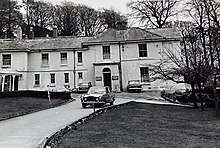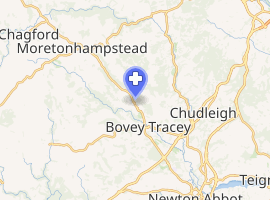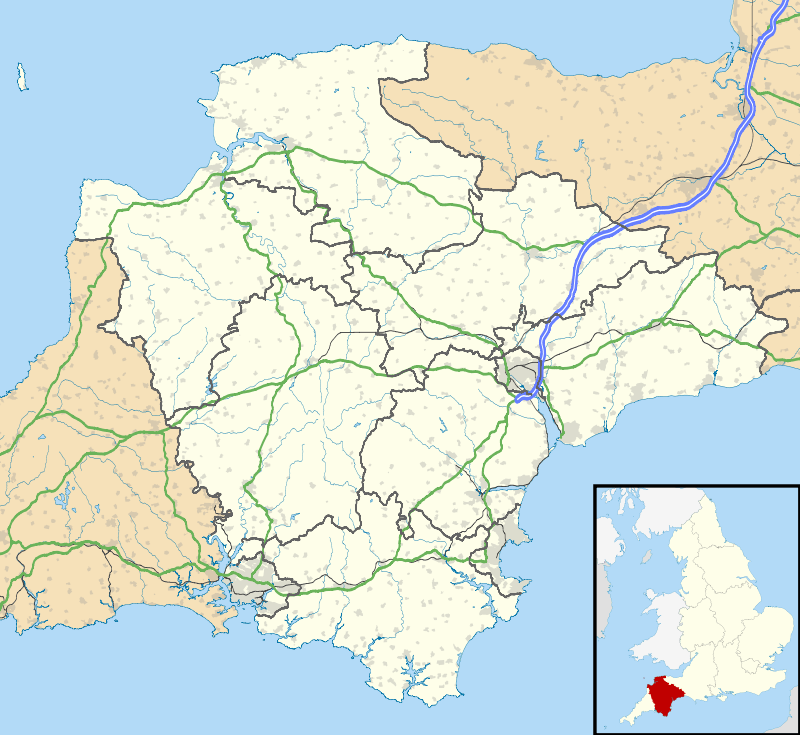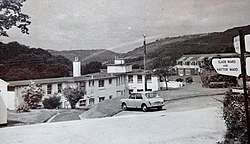Hawkmoor Hospital
Hawkmoor Hospital, originally known as Hawkmoor County Sanatorium, was a specialist hospital near Bovey Tracey in Devon, founded in 1913 as a pulmonary tuberculosis sanatorium as part of a network of such facilities.[1] From 1948, the hospital catered for both patients with chest ailments (including tuberculosis) and mental health patients, and in 1972 the facility was renamed 'Hawkmoor Hospital' and dealt solely with mental health problems until its closure in 1987.[1]
| Hawkmoor Hospital | |
|---|---|
 Hawkmoor House, Hawkmoor Hospital | |

| |
 Shown in Devon | |
| Geography | |
| Location | Bovey Tracey, Devon, England, United Kingdom |
| Coordinates | 50.615652°N 3.693491°W |
| Organisation | |
| Care system | Public NHS |
| Services | |
| History | |
| Opened | 1913 |
| Closed | 1987 |
| Links | |
| Lists | Hospitals in England |
History

The hospital, which formed part of a nationwide network of sanatoria designed for the treatment of pulmonary tuberculosis and made possible by central government grants worth £1.5 million awarded under the Finance Act 1912, opened in 1913.[2] The sanatorium initially opened in temporary accommodation with 40 beds available. The main building not completed until over a year later.[2] Training of nurses was shared by arrangement with the Royal Cornwall Infirmary in Truro.[3]
After the sanatorium joined the National Health Service in 1948,[1] the scope of treatment offered was expanded to include all pulmonary disorders as well as the acceptance of mental health services. It opened a specialist thoracic surgery unit and also offered services to treat conditions such as sarcoidosis and pulmonary carcinoma from 1950.[4]
In 1972, the pulmonary diseases facilities were withdrawn and the hospital became a facility specialising in mental disorders and was renamed 'Hawkmoor Hospital'.[1] The hospital closed in 1987 and the site has since been redeveloped for residential use as Hawkmoor Parke.[5]
Location and transport
From 1931 until 1959, Hawkmoor was also served by a railway station on the Moretonhampstead and South Devon Railway with a station originally called Hawkmoor Halt, but later changed to be called Pullabrook Halt.[6] The railway station was simple with a platform constructed of sleepers and a small waiting room, and was frequently used by visitors to the hospital.[6] Whilst only 3/4 mile directly from the station to the hospital, the distance required to be travelled was more than double that.[6]
References
- "Hospital Records - Hawkwoor". The National Archives. Retrieved 30 September 2018.
- "Written Answers (Commons) - Sanatoria HC Deb". Hansard. 65: 1578–9W. 1914-07-30. Retrieved 13 September 2013.
- "Education and Examination" (PDF). 87. The British Journal of Nursing. August 1939: 211. Retrieved 13 September 2013. Cite journal requires
|journal=(help) - "Obituary - N P W Littler". British Medical Journal. 290 (6461): 84. 1985-01-05. PMC 1415426.
- "Life and death of Hawkmoor". Herald Express. 2008. Retrieved 30 September 2018.
- Hokman, Dave. "Pullabrook Halt". Disused Stations. Retrieved 30 September 2018.
| Wikimedia Commons has media related to Hawkmoor Hospital. |